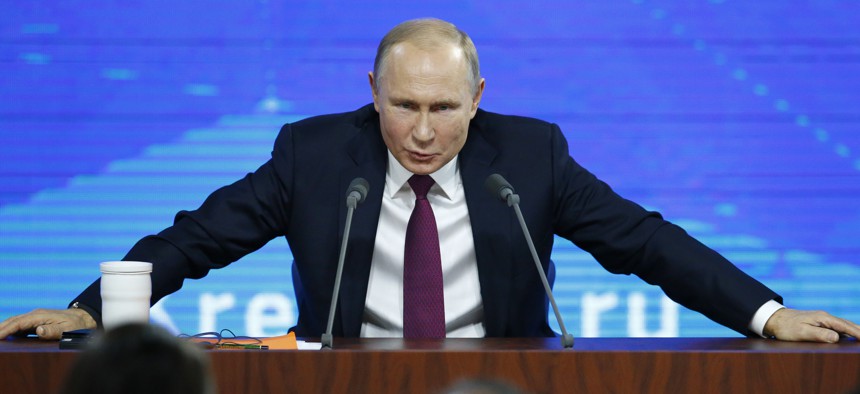
Russian President Vladimir speaks during his annual news conference in Moscow, Russia, Thursday, Dec. 20, 2018. AP Photo/Alexander Zemlianichenko
The INF Treaty Is Doomed. We Need a New Arms-Control Framework
The new approach will have to deal with a White House intent on acting unilaterally and a Russia seeking to reverse the effects of NATO’s eastward expansion.
Neither the Trump administration nor the Russian government appears the least bit interested in saving the Intermediate-Range Nuclear Forces Treaty. Both have their reasons, and the arms-control community would do well to drop its appeals on behalf of the INF and take a hard look at what has changed.
U.S. accusations of Russian INF violations first became known publicly in 2014. In the past few weeks, the Trump administration released a dossier detailing the intelligence behind its claims. Since 2014, the Russian government has repeatedly denied the accusations and countered that the United States itself was in violation of the treaty. However, the majority of governments on both sides of the Atlantic and independent arms control experts agree that Russia has violated the treaty. Most also find the Russian counter-claim to be dubious.
Since the Obama administration first charged that Russia violated the treaty by testing the banned missile the Kremlin has proceeded to actually deploying it. Russian actions have made it clear that the initial violation was no mere oversight, but a deliberate move.
The Kremlin has always had the option of withdrawing from the treaty, as the United States did with the Anti-Ballistic Missile Treaty in 2002. But that would have triggered widespread international criticism. Instead, the Kremlin left it to the United States to make the first move. The Trump administration obliged, handing Mr. Putin a major public relations victory. Instead of mounting an effective public relations campaign focused on Russian INF violations, the United States has painted itself as the offender.
Related: Nothing About Trashing the INF Treaty Makes the US Safer
Related: Four Perfectly Trump Reasons Why He Wants Out of the INF Treaty
Related: Moscow Has Little Reason to Return to the INF Treaty
Mr. Pompeo’s Dec. 4 ultimatum to the Kremlin is intended to kill, rather than save the treaty. There is zero chance that the Kremlin will back down under U.S. pressure from the course it embarked on years ago. The Trump administration’s reasons for killing the treaty—aside from the fact that in the four years since Russian violations were first made public Russia has proceeded from testing the missile to deploying it—are obvious. President Trump doesn’t like treaties that he did not negotiate. NAFTA, the Trans-Pacific Partnership, even the North Atlantic Treaty are in his view deeply flawed and do not serve American interests. The INF Treaty is important to U.S. European allies, in particular Germany, which has been a frequent target of Trump’s ire. That is probably one more strike against the treaty in the President’s eyes. His National Security Advisor John Bolton is a long-time critic of arms control and has argued consistently for getting the United States out of the web of treaties that he says deny it the freedom to provide for its own defense. Finally, some U.S. defense experts claim, the United States needs intermediate-range missiles to counter China.
The Kremlin too has its reasons for disliking the INF Treaty, which bans land-based, but not air- or sea-based intermediate-range missiles. Russian defense planners have always viewed the former as an essential part of their arsenal, while NATO and the United States in particular have had a clear advantage in the latter systems. The dissolution of the Warsaw Pact and the break-up of the Soviet Union along with the expansion of NATO have fundamentally changed the geography of Russian threat perceptions. Successive rounds of NATO enlargement have pushed the NATO-Russia boundary much further to the east and removed the strategic depth that for centuries has been essential to Russian defense planning.
Without the buffer of the Warsaw Pact and the western republics of the USSR, the Russian heartland is now within a few minutes’ flying time of U.S. air- and sea-based weapons, which are allowed under the INF Treaty. Absent their land-based intermediate-range missile arsenal, Russian defense planners think they have few means to counter that threat. Top Russian officials, including Putin, have complained about the INF Treaty for years. Trump’s announcement of his decision to withdraw from it was a gift to them, shifting the blame on the United States as the offender.
With this confluence of interests between the Kremlin and the White House, the INF Treaty is doomed. The carrot-and-stick approach advocated by some experts—boosting NATO’s missile defenses, threatening Russia with conventional air- and sea-based offensive systems, while also offering it assurances about U.S. systems it claims violate the INF Treaty—will not be enough. Threatening Russia with air- and sea-based offensive systems will further demonstrate to the Russians that the treaty favors the United States. U.S. assurances that its systems that Russia claims violate the INF Treaty in fact do not, will fall far short of what Russian defense planners want—the ability to deter or defend against NATO’s threat to the Russian heartland.
It is impossible to separate the fate of the INF Treaty from the geography of the NATO-Russia standoff. NATO expansion has provided a robust security guarantee to the countries of Eastern and Central Europe—a guarantee they wanted as a hedge against precisely the kind of Russia they are dealing with today. But Russia rejects the European security order with NATO at its core, and the alliance’s expansion has resulted in a new climate of insecurity along its eastern edge. The asymmetry of the INF Treaty, which allows some intermediate-range systems, but not others, has doomed it in the eyes of Russian defense planners confronted with the new map of NATO and ever-improving U.S. offensive capabilities.
The fate of the INF Treaty is a wake-up call to arms controllers and strategists on both sides of the East-West divide. The arms control framework built during the Cold War is growing obsolete. It does not keep up with the rapid pace of technological change and the new geography of threats. It can still perform a useful function and serve as a platform from which to expand the conversation about managing the arms race in the new century. But in and of itself that framework is no panacea and could even distract from what is urgently needed—a conversation about strategic stability in an environment that both sides are ill-prepared to handle.
NEXT STORY: An Admiral Slammed the Shutdown. Can He Do That?




